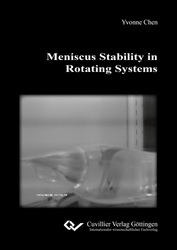| Fachbereiche | |
|---|---|
| Buchreihen (96) |
1378
|
| Nachhaltigkeit |
3
|
| Gesundheitswesen |
1
|
| Geisteswissenschaften |
2364
|
| Naturwissenschaften |
5406
|
| Ingenieurwissenschaften |
1793
|
| Allgemeine Ingenieurwissenschaften | 292 |
| Maschinenbau und Verfahrenstechnik | 862 |
| Elektrotechnik | 686 |
| Bergbau- und Hüttenwesen | 30 |
| Architektur und Bauwesen | 75 |
| Allgemein |
98
|
|
Leitlinien Unfallchirurgie
5. Auflage bestellen |
|
Erweiterte Suche
Meniscus Stability in Rotating Systems
Yvonne Chen (Autor)Vorschau
Vorwort, PDF (46 KB)
Inhaltsverzeichnis, PDF (57 KB)
Leseprobe, PDF (160 KB)
The knowledge of behavior of liquids with free surfaces to their surrounding gaseous phase in compensated gravity is essential to the development of tank systems for spacecrafts. In microgravity, the liquid behavior is dominated by capillary forces, which are used to position and redistribute liquid propellant in a desired way for the mission. The body forces occurring due to residual accelerations, which can be caused by spin during the ballistic flight phases, force the liquid to reorient towards a new equilibrium state of the free surface. Due to spin the liquid is driven away from the tank outlet and located along tank walls in partially filled tanks. To assure enough liquid fuel over the tank outlet, so-called Propellant Management Devices (PMD’s), are employed. A PMD is a static, usually metal structure, which either provides a passage way for a liquid in microgravity or stores a certain amount of liquid at a desired location. Some PMD’s are designed to be refillable in periods of microgravity due to openings in the outer housing or by a housing composed of perforated metallic sheets. These reservoirs are refilled in periods of compensated gravity in order to provide the required amount of liquid fuel for attitude control or other maneuverings. Relatively large disturbances, such as lateral accelerations and spin, can drive the liquid fuel out of the reservoir, resulting in malfunction of the device. During spilling, gas enters the device such that only a residual amount of liquid propellant can be kept in the reservoir. Moreover, the connection to the bulk liquid in the tank may be interrupted such that refilling of the reservoir is disrupted. Hence, a PMD with two parallel disks forming the inlet and a venting tube at the topmost point of the outer housing shall be designed such that its refillable structure is only filled with liquid without any gas or vapor being easily trapped during operations.
| ISBN-13 (Printausgabe) | 9783736990104 |
| ISBN-13 (E-Book) | 9783736980105 |
| Buchendformat | A5 |
| Sprache | Englisch |
| Seitenanzahl | 286 |
| Umschlagkaschierung | matt |
| Auflage | 1. Aufl. |
| Erscheinungsort | Göttingen |
| Promotionsort | Bremen |
| Erscheinungsdatum | 08.06.2015 |
| Allgemeine Einordnung | Dissertation |
| Fachbereiche |
Allgemeine Ingenieurwissenschaften
Technische Mechanik, Strömungsmechanik, Thermodynamik Luft- und Raumfahrttechnik |
| Schlagwörter | space, microgravity, zero gravity, capillarity, stability, rotation, free surfaces, menisci, curvature, drop tower experiments |








